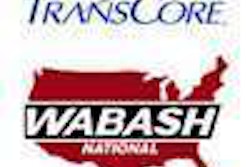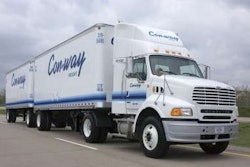Good information, attention to detail keep trailer fleets productive and safe
While trailers don’t have all the moving parts and complex dynamics that tractors do, they present tough maintenance challenges to fleet managers and technicians alike. They endure all the same road-inflicted hardships as power units, including exposure to the elements, rough roads and accidents. But trailers also are more likely to be damaged during loading and unloading operations, and they can sit idle for weeks or even months outdoors – often at remote locations – with little or no maintenance. Meanwhile, road salts, acids, wind and rain wreak havoc with their electrical systems, structural components, power and insulation units and brakes.
While volumes could be written about properly maintaining each of those separate trailer systems, adopting sound spec’ing decisions and diligent maintenance programs can go a long way toward making sure your fleet is getting the longest, most productive lives out of the boxes and platforms hauling your customers’ goods.
Where to begin
With any maintenance protocol, simply figuring out where to start is half the battle. Many fleets offer at least some trailers in more than one type, which adds to the complexity.
At Silby, La.-based Tango Transport, technicians must track and maintain more than 2,000 separate units – 80 percent dry van and the remainder flatbeds. Ken Eggen, vice president of fleet maintenance for Tango, believes that good trailer maintenance starts with educating all concerned parties on how to care for them while they’re out on the road. The company’s risk management group and its safety department both educate customers and drivers on proper trailer care.
“With our drivers, we really focus on the best places to park their trucks at night,” Eggen says. “We have found that much of the damage is inflicted to our equipment in truckstops and other shared parking areas. And simply parking in a secure location whenever possible can really help hold trailer maintenance costs down.”
Another simple maintenance trick also can contribute to longer trailer life. “We have truck washes in three facilities,” Eggen says. Frequent washes to remove road grime reduce the opportunity for corrosion.
GE Trailer Fleet Services says data collection and transmission have become critical to keeping its large fleet in good shape and on the road. “Trailer maintenance is absolutely vital to our operation,” says Patrick Brennan, spokesman for GE Trailer Fleet Services, which owns more than 100,000 trailers. “We perform more than one million repairs annually to the trailers in our fleet. So we know trailers.”
All of GE’s trailers are on a preventive maintenance schedule as well as the mandatory federal inspection schedule, Brennan says. The company’s technicians all have handheld devices that can record and transmit real-time repair data – including photos – to customers for rebuild procedures if needed.
“We are huge believers in technology as a way to keep our trailer maintenance current,” Brennan says. “It’s a real-time scenario, where that data is being transmitted as it’s being entered wirelessly to the branch computer.” With lots covering several acres, technicians can spend the afternoon out on the lot. But the manager and our customers don’t have to wait to get information on the trailers because it’s coming in all the time from the yard, Brennan says.
PDAs also have helped streamline operations in other ways. “They allow our customers to track their expenses through the data collected and make sound business decisions based on hard evidence of what’s happening out in the real world,” Brennan says. GE also uses PDAs to track technician productivity and identify their training needs. “We can also predict our sourcing needs and the deployment of maintenance resources based on that data.”
Spec’ing for longer life
For Steve Zaborowski, senior vice president of Xtra Lease, spec’ing trailers properly is as important as maintaining them. “We spec our trailers from the manufacturer to operate with high performance,” Zaborowski says. The company ensures that its trailers are built with low lifecycle-maintenance cost features such as LED lighting, extended-life brake linings and self-lubricating landing gear legs, all of which help extend maintenance intervals and reduce trailer downtime. “We also include damage-resistant features such as composite panels and deep threshold plates with extra crossmember reinforcement.”
Zaborowski says Xtra Lease also uses the spec’ing process as a way to make life easier for drivers and hopefully aid in retaining them, while also ensuring the trucks can be loaded as efficiently and productively as possible. The company specs driver- and loader-friendly features such as an air-assisted slider pin release on air-ride suspensions, as well as thinwall composite trailers or shallow logistics post sheet vans. “Those features make them easier to load for shippers while maximizing cubic capacity and payload,” he says.
Frequently looking for improvements to combat damages and repairs is another standard procedure at Xtra Lease, Zaborowski says; this process can occur as part of pre-buy spec’ing or as improvements made to units already in service. To that end, the company is adding more composite materials to its van interiors, which Zaborowski says provides for greater structural protection and helps them withstand damage more effectively.
Xtra Lease also uses translucent roofs that allow more light into the trailer, providing a forklift operator with better vision and minimizing damage exposure. “And the introduction of the enhanced tear-resistant surfaces several years ago prevents a cut from further spreading and becoming a major structural problem,” Zaborowski says.
The company also has increased the floor weight ratings of its trailers to allow for heavier forklift loads. “In addition, we’ve tightened our crossmember spacing to provide for greater reinforcement throughout the trailer,” Zaborowski says. “We also build our trailers with a large threshold plate at the rear.” That feature, combined with additional supporting rear crossmembers, helps provide better structural integrity and protection, particularly at the loading point where the forklift driver typically hits the trailer.
Another feature that Xtra Lease has incorporated successfully into its dry van design is a fluted aluminum side scuff liner. “This product is lightweight and damage-resistant,” Zaborowski says. “We also use a smooth, steel nose scuff, overlaid on composite material nose liners, for added protection during loading and unloading.”
Challenges continue
At the end of the day, keeping trailers on the road boils down to proper preventive maintenance by technicians and the unit’s ability to ward off specific problems. Xtra Lease has partnered with its OE suppliers to combat corrosion, minimize electrical failures and keep reefer operation as dependable as possible.
“We’re experimenting with coating solutions that provide better protection of trailer undercarriages and associated components to minimize corrosion,” Zaborowski says. This includes looking at new coating methods and working with paint companies to come up with stronger, more reliable coatings that better protect components susceptible to damage, corrosion and harsh climates. “We’re also seeing some migration to galvanized components that provide better protection from roadway chemicals, most notably in the trailer’s rear frame,” he says.
Trailer manufacturers and their suppliers have strived in recent years to take steps toward reducing the impact of corrosion from road de-icing chemicals and other irritants, and from changing weather conditions. Sloan Transportation Products and Phillips Industries, suppliers of electrical connectors and components, have introduced anti-corrosion/anti-weather products. Trailer manufacturers also are trying to fight corrosion through new undercoatings such as Great Dane’s CorroGuard.
On the electrical front, Xtra Lease has converted to filament-free LED lighting, which Zaborowski says has eliminated vibration-related failures and improved overall system performance while reducing the number of lighting repairs and replacements. “Our technicians are also sealing LED lights in epoxy to keep the moisture and corrosion out,” he says. “And we’re investigating advancements in lighting harness design that make them more corrosion-resistant as well.”
Reefers provide their own litany of maintenance challenges. Zaborowski says a close relationship with ThermoKing has paid dividends for Xtra Lease, which now is migrating to thermoplastic liners on the interior, which are stronger, lighter and more impact-resistant; they also are easier to repair when damage does occur.
However, Zaborowski says the introduction of biofuels has been a challenge for reefer units. “Our data shows use of these fuels has created some problems, with fuel-filter clogging being the most common,” he says. “We’re working on solutions now to combat that problem.”
Brennan says GE Trailer Fleet Services currently is focused on two specific trailer technologies related to pending or current regulatory requirements by the California Air Resources Board. The U.S. Environmental Protection Agency on Jan. 16 cleared CARB to begin enforcing on July 17 its regulations to reduce particulate matter in transport refrigeration units (TRUs). The rules require TRUs older than seven years old to be retrofitted or replaced for lower emissions. “Given the number of reefer trailers that will need retrofitting, this will be a huge task and expense for us,” Brennan says.
Another CARB regulation requiring aerodynamic skirting retrofits also will change trailer maintenance dynamics in the near future. “This regulation will have a much larger impact on us because it applies to all trailers – not just reefers,” Brennan says.
Beginning Jan. 1, 2010, 2011 and newer 53-foot or longer box-type trailers will be required either to be certified by EPA’s SmartWay Transport Partnership or retrofitted with SmartWay-approved technologies, such as trailer skirts and front and rear fairings. By Jan. 1, 2013, fleets will have to retrofit all 2010 and earlier model year 53-foot box-type trailers.
Alternatively, a fleet can choose to abide by a compliance schedule varying by fleet size as long as it agrees to CARB auditing.
Although CARB is phasing in its aerodynamic skirt requirement, Brennan doesn’t believe the OE supplier base is ready based on the number of trailers that will have to be retrofitted. “But clearly we will be installing them on our trailer fleet,” he says. “And again, our goal will be to develop a competency and outreach to our customers and others that will need those not only initially installed but also as they get broken and fall off on the road. Our guys will be ready to repair them.”
For now, GE is working closely with the American Trucking Associations and its California team to stay on top of the regulations. “The aero skirt requirement is the biggest thing coming down the road in regard to trailer maintenance,” Brennan says. “It’s a very serious effort, and for fleets the size of ours, very expensive. Clearly for us, it will cost millions of dollars to outfit our fleet coming at an inopportune time this year. But as a company and an industry, we have no choice but to prepare for it and be ready when it comes into effect.”
As if managing and maintaining trailers weren’t inherently tough enough, fleet owners must watch carefully that other parties – including federal and state governments – don’t make the job harder.
GE’s Top 10 trailer repairs
Through sheer volume, GE Trailer Fleet Services is well versed on the numerous challenges required to keep trailers safe and productive. According to data compiled from its technicians’ handheld devices in 2007, the company has identified its Top 10 most frequent trailer repairs:
1. Preventive maintenance, inspection and safety checks
2. Clearance and marker light repairs
3. Tire replacement
4. Wiring (both cut and corrosion)
5. Mudflap and bracket replacement
6. Decal removal and installation
7. License plate and light repairs
8. Brakes
9. Replacing wheel seals
10. Roof repairs
“We can also crunch that data in a lot of different ways,” says Patrick Brennan, GE Trailer Fleet Services spokesman. For example, tires are not GE’s most frequent repair, but they are the most expensive. The company’s second-priciest repairs are for preventive maintenance and safety checks, with bottom, top and nose rail repairs coming in third. Liftgate repairs, which are not among the most common repairs, are among the 10 most expensive. “It gives us a real good handle on what’s going on out in the shop,” Brennan says.













